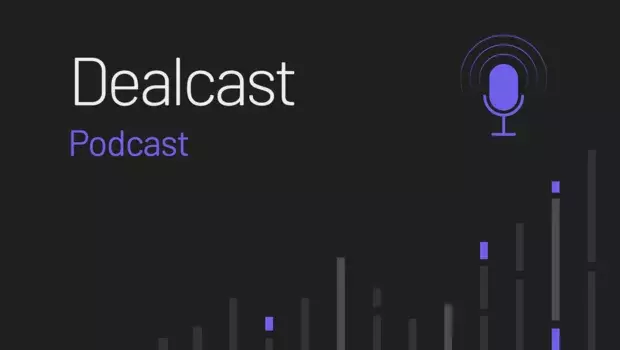abrdn Examines The Thriving Private Equity Secondaries Market 2022
In this week’s podcast, we discuss the private equity secondaries market. We explore how the sponsor-led secondaries segment is thriving, while the market for classic LP portfolio secondaries has been rather subdued. To learn more, we’re joined by abrdn’s Patrick Knechtli, head of secondaries, private equity; Jin Yan-Staal, investment director; and Cameron Graham, deputy head of secondaries, private equity. Dealcast is presented by Mergermarket and SS&C Intralinks.
In this episode, you’ll learn about:
- Why secondaries are appealing to investors
- Drivers of growth in GP-led secondary transactions despite market volatility
- Can market growth in the GP-led space be maintained?
- Potential impact of scrutiny from regulators
- How LP portfolio secondaries will evolve in an uncertain environment
Dealmakers, sign up for our monthly INsights newsletter here.
Transcript
[MUSIC PLAYING] JULIE-ANNA NEEDHAM: Welcome to Dealcast, the weekly M&A podcast presented to you by Mergermarket and SS&C Intralinks. I'm Julie-Anna Needham, a journalist who's been covering M&A for a decade. This week's special episode is in partnership with Aberdeen. In it, we'll be discussing the thriving private equity secondary market in 2022. Today I'm joined by Patrick Knechtli, head of secondaries, Jin Yan-Staal, who is an investment director, and Cameron Graham, the deputy head of secondaries, all at Aberdeen.
[MUSIC PLAYING]
Hi, Cameron, Jin and Patrick. Thanks very much for joining me today.
CAMERON GRAHAM: Hello.
JIN YAN-STAAL: Hello.
PATRICK KNECHTLI: Hello.
JULIE-ANNA NEEDHAM: So to begin with, could you please provide some context around what is a secondary and the different types of deals available within the market? And that question to you, Patrick.
PATRICK KNECHTLI: Yes, sure. I think it's useful to provide a bit of context here, and maybe I'll provide a bit of background as well. So a secondary deal is, in our world, a purchase of an interest in a fund or a portfolio of private assets. So that's as opposed to a secondary buyout or any other form of secondary.
A couple of things to bear in mind, sort of two key differences in private equity secondaries to other forms of secondary trading like listed equities or listed bonds is that not all investment vehicles are the same. So each limited partnership document is a highly negotiated agreement. And the second thing is that you always need the consent of the GP or manager of the fund to transfer. And that's very important, particularly in the part of the market that we participate in.
Just in terms of the different types of secondaries, there's been quite a lot of evolution over the years. So back in the early days, the mid to late '90s, there were a few one-off trades of portfolios and fund interests by institutional investors and high net worths. These are the types of deals that people think of as the classic secondary or LP deal, as in the LP, the limited partner within the fund, is the one who initiates the transaction and tries to sell their interest. In fact, our predecessor firm Standard Life was one of the first institutions in Europe to participate in one of these sale processes.
And then in the 2000s, it was really the banks that were the big sellers of private equity portfolios, both setting fund portfolios and their own in-house private equity operations, which were kind of more complex deals. They involved buying direct stakes in businesses, and therefore, they were referred to as secondary direct deals. In the 2010s, pension funds really started to use the secondary market more regularly to offload non-core private equity exposures and rebalance their portfolios, and that led to some much larger LP trade, so sort of $500 million to $1 billion transactions. And then in the last five years, we've seen some of the best quality GPs, managers in the market really embrace secondaries as a way to offer more consistent liquidity to their investors and to hold favored assets for longer. So this is the so-called GP-led or sponsor-led space.
Alongside those two broad categories of LP secondaries and GP-leds, there's been a lot of other innovations within the market, so strip sales, preferred equity deals, tender offers, stapled transactions. But to keep it simple and to avoid too much jargon, you should think of secondaries as a means of providing liquidity to investors in what would otherwise be illiquid private market portfolios.
JULIE-ANNA NEEDHAM: Great. Thank you. And Jin, coming to you, Patrick touched on some of it there, but what is the appeal of secondaries for investors?
JIN YAN-STAAL: So investors like secondaries because traditionally, the classic LP secondaries offer attractive risk-adjusted returns. They not only offer immediate access to diversified private equity exposure in terms of stage, geography, sector, and fund manager but also backward vintage diversification, which is especially valuable to investors who are new to the asset class. LP secondaries also offer visibility on portfolio quality, which reduces the blind pool risk versus primaries because investors can assess the underlying asset quality, the manager's execution progress versus their stated strategy, and exit potential. In addition, LP secondaries can reduce or eliminate the often talked about dreadful J-curve due to shorter time horizons, potential discount pricing, and embedded value and growth within the portfolio.
On the sell side, secondaries also offer a great portfolio management tool for LPs who seek to generate liquidity for their private equity assets. As mentioned by Patrick earlier, the more recently developed GP-led secondaries also provide investors the opportunity to access high-quality assets managed by top-quality GPs with the potential to generate attractive returns, especially multiples, albeit with the risk of more concentration. So this is something that we didn't see five or so years ago in the secondaries market.
So all this what combines to are good risk-adjusted returns if you get it right in secondaries. Investors can get their money on the ground quickly and get it back quickly. That's why secondaries are so attractive to investors.
JULIE-ANNA NEEDHAM: Thank you. And Cameron, coming to you, the GP-led or sponsor-led secondary segment has attracted huge interest and seen really strong growth in recent years even during the volatility of the past few years. Can you outline what the drivers are of this growth, please?
CAMERON GRAHAM: Yeah, sure. I mean, the growth really has been remarkable, hasn't it? I mean, Patrick would argue and you just mentioned it, that it's been part of the market in the guise of secondary directs since way back in the olden days when he started out in secondaries. But really, the GP-led world, as we know it today, has really grown from a standing start of a decade ago up to pretty much half the market today. And frankly, the majority of that growth has been in the last three, four, or five years, so it's been pretty impressive.
In my mind, it went through something of the same early evolution as secondaries more generally, albeit fast forward to an extent, in that it really started out in this domain of distress with tougher assets or GP situations. And cynically, you could see that some of those early trades were really kind of franchise-extending exercises for some of the managers and weaker managers at that point in time. But it really has transformed in the last four or five years such that, as Patrick alluded to, it's been entirely embraced by the best GPs in the business as a portfolio management tool or fourth exit route for, oftentimes, their very best asset.
In terms of what sustained the growth in the last couple of years of volatility, so relatively speaking, it's a space that tends to bounce back more quickly from market corrections and dislocations, really just owing to the more concentrated nature of the portfolios. I mean, oftentimes, it's single company exposures, so buyers and sellers are armed with more current trading and valuation information in contrast to big, diversified LP portfolios where you've got that natural lag on those factors, which creates a bit of a hiatus for a couple of quarters while things normalize and that information comes through. But, I mean, overall, I would say it's been driven by a well-capitalized and a really quite innovative buyer universe, coupled with that growing acceptance and awareness amongst GPs as to what's possible, so with the burgeoning demand and supply side.
But that said, my view is that it's still pretty hopeful. There's a long way to go. It's amazing that we're sat in front of some of our GPs who will no doubt have been spoken to by various intermediaries over the time. But how unaware some of them are, particularly at the lower end of the market, as to what's possible for them in the secondary market. So there's more to come.
JULIE-ANNA NEEDHAM: Right. Thank you. And Patrick, coming back to you, can this momentum, this kind of increase in growth be sustained?
PATRICK: Yes. I mean, I think in the short term, there's bound to be some impact from the overall market slowdown as buyers and GPs readjust to the new circumstances. And we have, in fact, seen that some of these GP-led deals are taking longer to complete nowadays. In the last few months, pricing has probably become a little less frothy and even the GPs' demands in terms of their economics have modified somewhat.
But on the flip side, with the usual exit markets becoming more constrained, so it's very difficult to IPO businesses these days. The debt markets are tougher to actually finance secondary buyouts, for example. GP-led deals could actually become an even more attractive means for GPs to continue providing liquidity to their investors.
So I think that's short term. Looking kind of longer term, I think the GP-led phenomenon has only really just got started and will continue gathering momentum. I think there's been some GPs who've been really enthusiastic early adopters and have already completed several continuation fund deals.
There are some GPs now who actually see it as a kind of automatic right that they have to offer to their LPs when they get to year 9 or 10 in a fund life, to actually go through some kind of a liquidity process. So that's another example. There will be more of that.
But as Cameron says, there's a sort of an almost trickle-down effect. So some of these big early adopters, they tend to be the larger GPs. There is a trickle-down effect to the mid and lower mid-market where we're typically more active, even at our level as well.
So we're generally talking here about people making direct deals into companies. People like us who are generally investing in funds, so fund-to-fund or secondary players. We've also embraced this technology, and that would sort of fall within this GP-led space as well. So there's a lot to do there.
Just thinking on the other side, what could put a brake on developments? Well, there has been some increased scrutiny from the regulators on how GPs and buyers are navigating some of the inherent conflicts of interest. But again, I think that's just more of a learning process over time. And then, of course, if the performance of some of these GP-led deals ends up disappointing, then that will cause investors and other people to kind of question this. But generally speaking, I think there's a hell of a lot of momentum behind this part of the market, and it will continue to grow.
JULIE-ANNA NEEDHAM: Great. Thank you. And Jin, coming back to you. In contrast to the GP or sponsor-led market, the market for classic LP portfolio secondaries has been rather subdued since the onset of the COVID crisis. Can you explain why that is and how you see LP portfolio secondaries evolving from here?
JIN YAN-STAAL: Good observation. So during COVID, diversified LP portfolios might have exposures to assets and sectors that have been impacted by the pandemic. So it's unclear what that impact would be because private equity funds are valued on a quarterly basis. LP portfolio secondaries are based on often stale or irrelevant valuation date. So it's difficult for buyers to price that in.
Also, as we hit the tech downturn this year, the same thing applies. It's unclear how that is coming through in terms of valuations and performance. But particularly in Q2 this year, we have noticed some wide bid-ask spread in the LP portfolios resulting in transaction pauses.
We have had ongoing, often direct LP portfolio discussions in recent months. Especially in our niche areas of the market, you often find that you are actually not necessarily competing with other buyers but with sellers' expectations, which may be anchored to clearly dated NAVs. But now, we are actually seeing some very interesting and actionable LP situations, both direct and intermediated, where we have a clear angle. And the sellers' expectations have recalibrated to a more realistic pricing level.
In terms of how the LP portfolio secondaries are evolving from here, I think the general expectation across the market is that LP volume will pick up in Q4 of Q2 marks, which may or may not fully reflect the current market backdrop. But pent-up supply should come through, and many investors facing overallocation pressures through the denominator effect and/or liquidity issues, perhaps due to true distress in those cases, have to come to market.
JULIE-ANNA NEEDHAM: Great. Thank you. And Cameron, there's obviously a lot of volatility at the moment touched on by Patrick earlier. How do you navigate the challenges of weighing up the risks between buying assets in this kind of uncertain or volatile environment at the same time as trying to capture the investment opportunities at attractive prices?
CAMERON GRAHAM: I guess at times like this, it's easy just to sit in your hands. Investment committees can get jittery and that sort of thing. But clearly, these situations, as your question implies, actually do throw up quite exciting buying opportunities. And actually, secondaries, historically, have done really, really quite well, performance-wise, out of these sort of tough backdrops.
But clearly, you need to exercise caution, for sure. I mean, we will focus on various things. But first of all, I guess, diversification of risk. So we're pretty thoughtful across all bases, whether that's sectoral, manager exposure or deal type, LP-led, GP-led as we look at transactions and then as we also build out the composition of our overall portfolio. I think recently, as we saw on COVID and previous dislocations, there's more discussions with sellers on downside protected structures.
I think, probably the most important thing from our perspective is focusing on buying quality, so quality assets managed by quality GPs, and crucially, stuff we know. So we overlay that quality with real selectivity. We're not deploying massive funds, and yet, we sit within a huge private equity platform. So we can really triangulate across our core investment nook for relevant touchpoints and across our vast manager relationship to triangulate and identify that embedded value such that we've got confidence pulling the trigger at times like this.
And we saw that with pretty good success, actually, through the depths of the COVID crisis. There were a number of deals that we did through that which bore all those hallmarks. One that jumps to mind in particular was, I think it was June 2020, so right in that point of fear.
Frankly, everybody sat at home not knowing which way things were going at all. We received an inbound sort of distressed seller situation, needed liquidity quickly. And it wasn't a small portfolio of funds managed by one of our top, lower-bid markets by managers kind of below the radar shop, and one that frankly, you'll never see trading in the secondary market ordinarily and a highly restricted GP, so they don't let anybody buy into their funds. We think there was probably two or three other buyers that might have been able to address this.
But this was a diversified portfolio. Yeah, there was some industrial consumer assets that we needed to get our head around. But it was a portfolio of say 30 assets across three of their funds that we've lived with from the beginning as a primary investor, sat on the advisory board. So we've lived with this manager and these assets throughout. And obviously, we're then able to get the current inside track from the GP, which allowed us to move quickly, and as I said before, pull the trigger on that portfolio at a tough time. And those dynamics of quality coupled with the backdrop from a macro perspective and our angle allows for a pretty wide discount on what buy rate should have clearly been a premium trade if frankly if it was available to trade in the secondary market at all.
JULIE-ANNA NEEDHAM: Thank you, Cameron. And staying with you, I'm bringing in Patrick here. How competitive is the secondaries market? How do you manage to differentiate yourself when doing deals and raising capital?
PATRICK KNECHTLI: I'll take the first part of that. Secondaries has always felt like a competitive market in the 20 or so years I've been involved. But thankfully, we have seen pretty consistent growth and innovation that has allowed for new entrants coming into the market, including our own program actually started off about 10 years ago.
One measure that people look at when they're thinking about competition is the amount of dry powder or available capital for new deals relative to the deal volumes in the market at any one time. That measure has varied between around 1.5 times deal volume and three times. Right now, it's actually at the lower end of that, so it's about 1.5, 1.6. But we do know that there are a number of big secondary firms that are gearing up for new fundraisers. And there are some new entrants coming into the market, particularly into the GP-led space.
So I don't think competition is lessening by any extent, but what we have seen as well is the market has grown and matured. And as you might expect, it has continued to segment with different players focusing on different parts of the market. And in fact, that's exactly what we've done.
We definitely focus on those less well-addressed areas of the market, typically shying away from the big, high-profile, billion-plus dollar deals and focusing on areas that are typified by generally just greater levels of opacity of information, access challenges, and so on, which clearly leads to relatively lower competition than that highly competed mainstream market. And we think that offers some relative value for not compromising on asset quality at all. As I said before, we're deploying relatively small funds relative to our huge, broader, global, private equity platform such that we can pick our spots and identify those angles and where we've got a reason to win, such that, as they say, early stages tend to be, by definition, lesser-traded opportunities at the predominantly lower end of the buyer market, whether that be LP trades or GP-led transactions.
JULIE-ANNA NEEDHAM: Great. And Jin, the final question to you, Cameron mentioned one example earlier, but can you give us some examples of recent deals that you've been involved in, please?
JIN YAN-STAAL: Of course. So late last year, we acquired a diversified LP portfolio of funds and co-investments where we were one of the three approved buyers in the process. We had good coverage and insight on many of the assets.
As you know, underwriting co-investments are particularly tricky. You can't price such assets unless you know them and have underlining GP relationships. Given the competitive dynamics of this transaction, we were able to actually acquire the portfolio at a material discount.
Even during the frothy market conditions last year, we were able to buy such high-quality assets at a discount. And so far, the deal has done what we think it's going to do, if not better. But we have had more than 50% of our final purchase price already distributed less than a year into the deal, so we're really very pleased with it.
JULIE-ANNA NEEDHAM: Great. Jin, Cameron, and Patrick, thank you very much.
[MUSIC PLAYING]
Thanks to Patrick Knechtli, head of secondaries, Jin Yan-Staal, investment director, and Cameron Graham, head of secondaries, all at Aberdeen. And thank you for listening to this week's special episode of Dealcast presented by Mergermarket and SS&C Intralinks in partnership with Aberdeen. Please rate, review, and follow or subscribe to the podcast. You can find us on Apple podcasts, Spotify, or look out for your Mergermarket news alert. For more information, have a look at our show notes. Join us next week for another episode.




